scroll down for English version
Che cos’è il premio sentinella? Un’idea nata a fine 2021 e concretizzatasi solo dopo un percorso non proprio semplicissimo e con il costante dubbio di non riuscire a portarlo a termine. Il “Premio sentinella“ è la rappresentazione tridimensionale dell’iconica concrezione a guardia della sala del tesoro del Ramo dei Lucchesi nell’Antro del Corchia, nonché simbolo dell’Associazione culturale SpeleoFotoContest, che punta a diventare anche un simbolo dell’eccellenza speleologica.
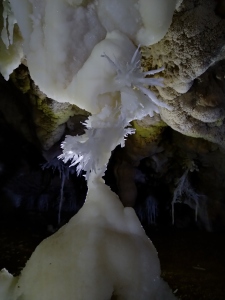
La sentinella è una concrezione tanto affascinante quanto fragile, rappresentando essa stessa la millenaria delicatezza del mondo sotterraneo, e dunque l’importanza della sua tutela per favorirne la conoscenza soprattutto al di fuori della comunità speleologica. Per questo dopo una lunga gestazione, fu messo a punto un progetto per la realizzazione prima di un rilievo tridimensionale, poi della sua elaborazione per la stampa in resina di un modello che la rappresentasse.
Grazie alla fondamentale collaborazione di Daniele Pagli e di Paolo Billeri del Gruppo Speleologico Torrentistico Speolo di Fucecchio FI, furono effettuate alcune prove preliminari per capire quale fosse la miglior soluzione per ovviare alle varie difficoltà tecniche del progetto, prima fra tutte quella relativa al trasporto in loco delle attrezzature necessarie, di conseguenza la messa a punto della tecnica da impiegare, e, non ultimo, l’aspetto economico.
Alla luce di tutte queste incognite fu scelta la tecnica della fotogrammetria, mediante l’utilizzo di fotocamere e smartphone per ottenere varie serie di immagini da elaborare sia tramite software che mediante l’utilizzo di una specifica applicazione. Le prove a casa avevano dato risultati soddisfacenti solo in parte: le simulazioni avevano evidenziato come fosse necessario avere dei “target” precisi per poter migliorare la risoluzione dei dettagli dell’immagine tridimensionale, specialmente in condizioni di illuminazione non sufficiente e su di una superficie con dettagli più piccoli, che in condizioni normali sarebbe stato facilmente risolvibile, ma in condizioni molto particolari come in questo caso diventavano montagne insormontabili, non avremmo potuto di certo ricoprire la Sentinella di target adesivi!
Ma una soluzione doveva pur essere trovata, e fu lì che Daniele ebbe, è proprio il caso di dirlo, l’illuminazione: “Perché non proviamo con i puntatori laser?” Bingo! Ecco la soluzione pratica, economica ed efficace, in grado di garantire allo stesso tempo la tutela dell’incolumità della Sentinella. Tre puntatori laser a griglia di punti opportunamente posizionati su cavalletti e tre piedi intorno al soggetto avrebbero creato un reticolo capace di dare alle foto una miriade di punti di riferimento fissi, conferendo così al modello ottenuto un grado di precisione nei dettagli più che accettabile.
Ormai era tutto pronto, il metodo era stato messo a punto e non restava che applicarlo. Agli inizi di marzo nel giorno X prefissato, una squadra composta da Daniele, Paolino, Pallina (Sandra) e Nedo (Luca), si trovò pronta per attaccare la “risalita dei Lucchesi” carichi di attrezzatura e di buona volontà e speranza nella buona riuscita dell’impresa. Arrivati in cima, dopo aver obbedito al cartello “ATTENZIONE stai entrando un una zona estremamente delicata, dimentica di essere un uomo” lasciando l’attrezzatura di progressione che avrebbe potuto nuocere all’ambiente di quel ramo, abbiamo iniziato ad allestire il “set” restando subito sbalorditi per l’effetto degno del miglior spettacolo di psichedelìa dato dal reticolo di puntini verdi, specialmente spegnendo tutte le altre luci, ma anche per i “raggi fotonici” che si venivano a creare grazie al vapore che emettevamo, essendo “lievemente” accaldati dopo la risalita (vedi fotogallery).
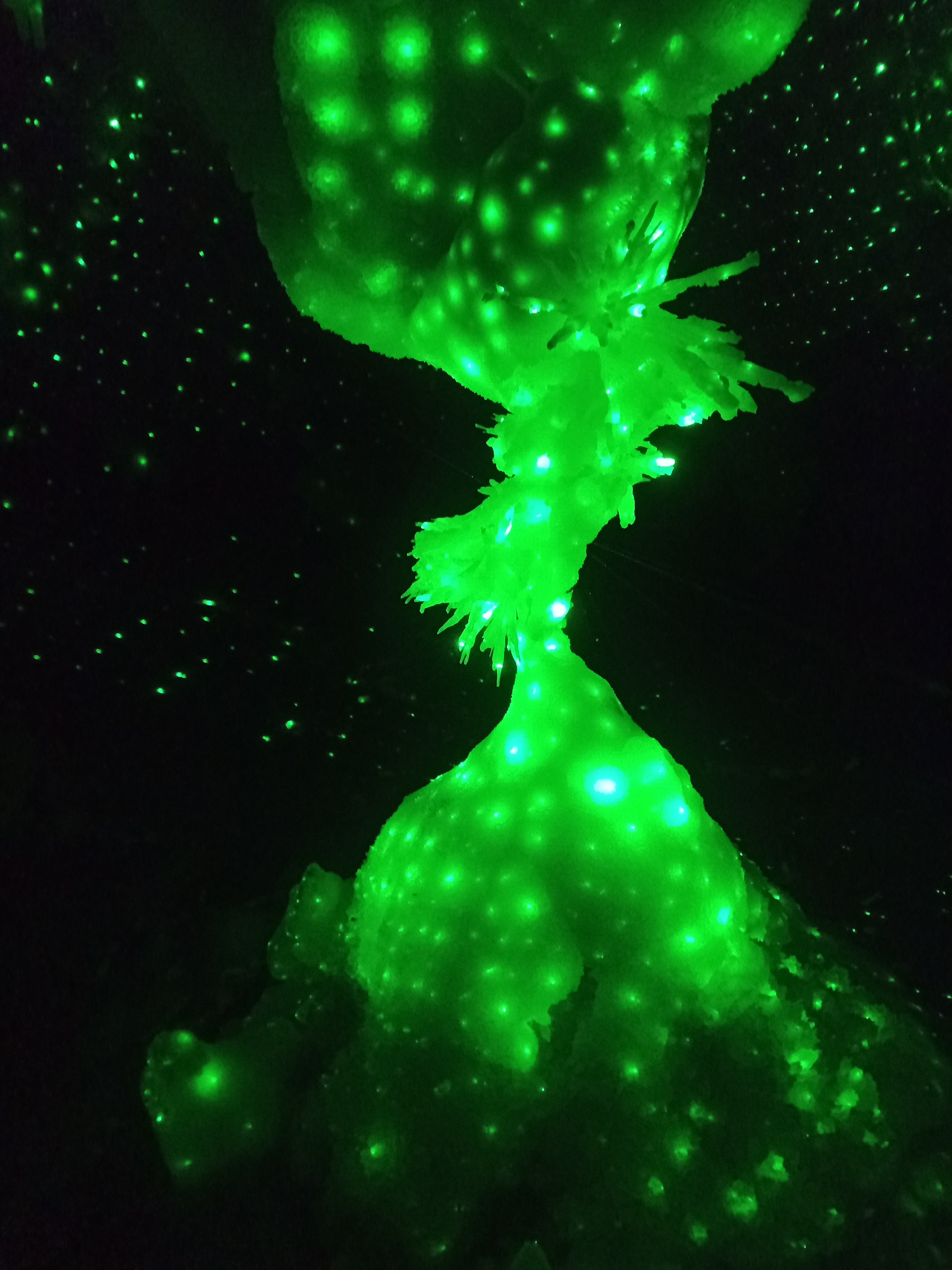
Sono state scattate numerose fotografie sia con la fotocamera che con lo smartphone al fine di ottenere due serie di foto da provare ad elaborare con il pc e con una applicazione sullo smartphone, quella stessa applicazione che, tradendo le aspettative che ci vedevano particolarmente scettici, si è rivelata estremamente pratica ed efficace, dandoci la possibilità addirittura di visualizzare in anteprima il modello elaborato direttamente sul posto. La parte “Faticosa” adesso era stata fatta e dopo la foto di gruppo d’ordinanza non ci restava altro che rientrare lasciando quel luogo meraviglioso e delicato dove noi altro non eravamo se non intrusi che dovevano andarsene il prima possibile.
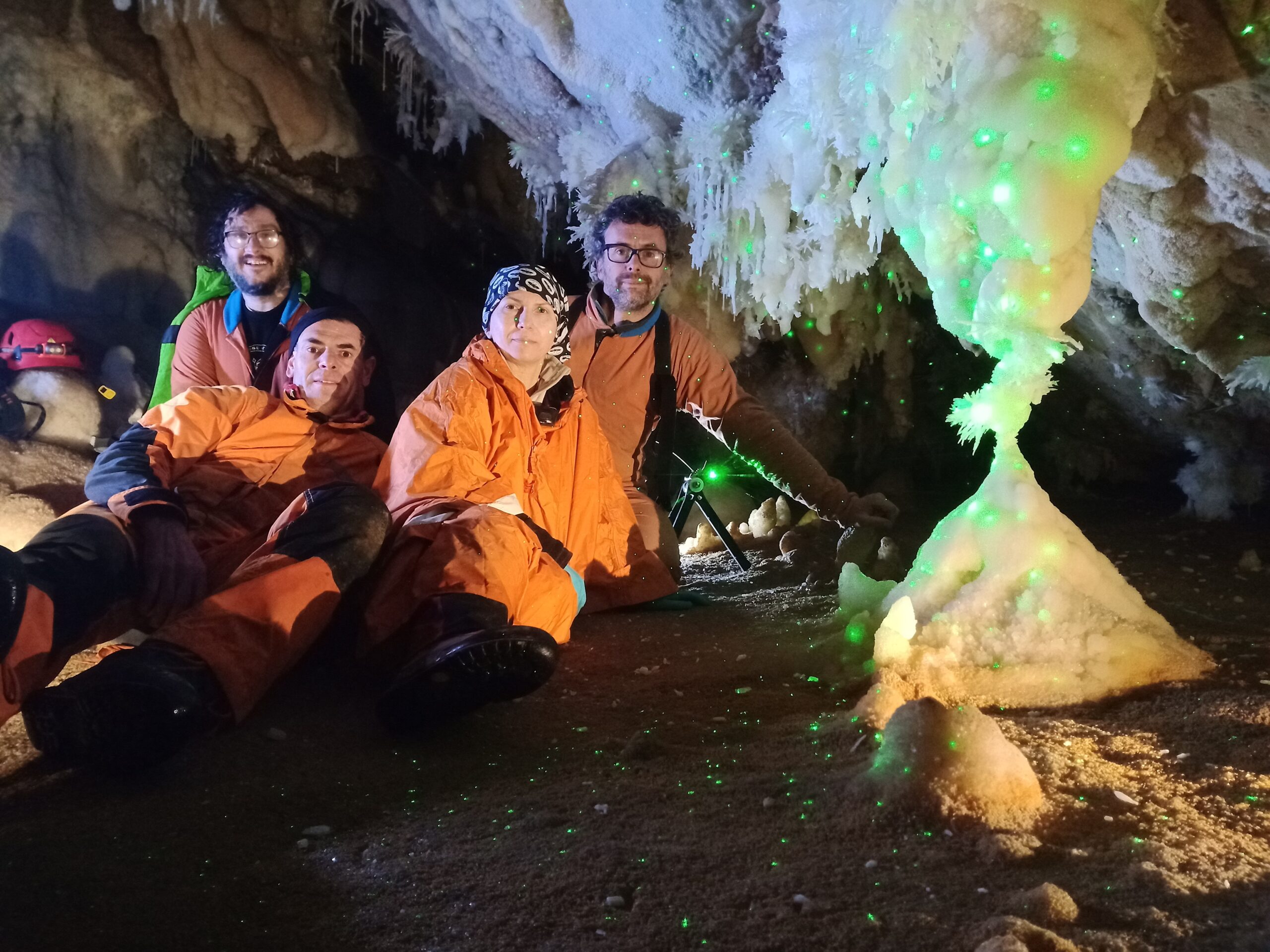
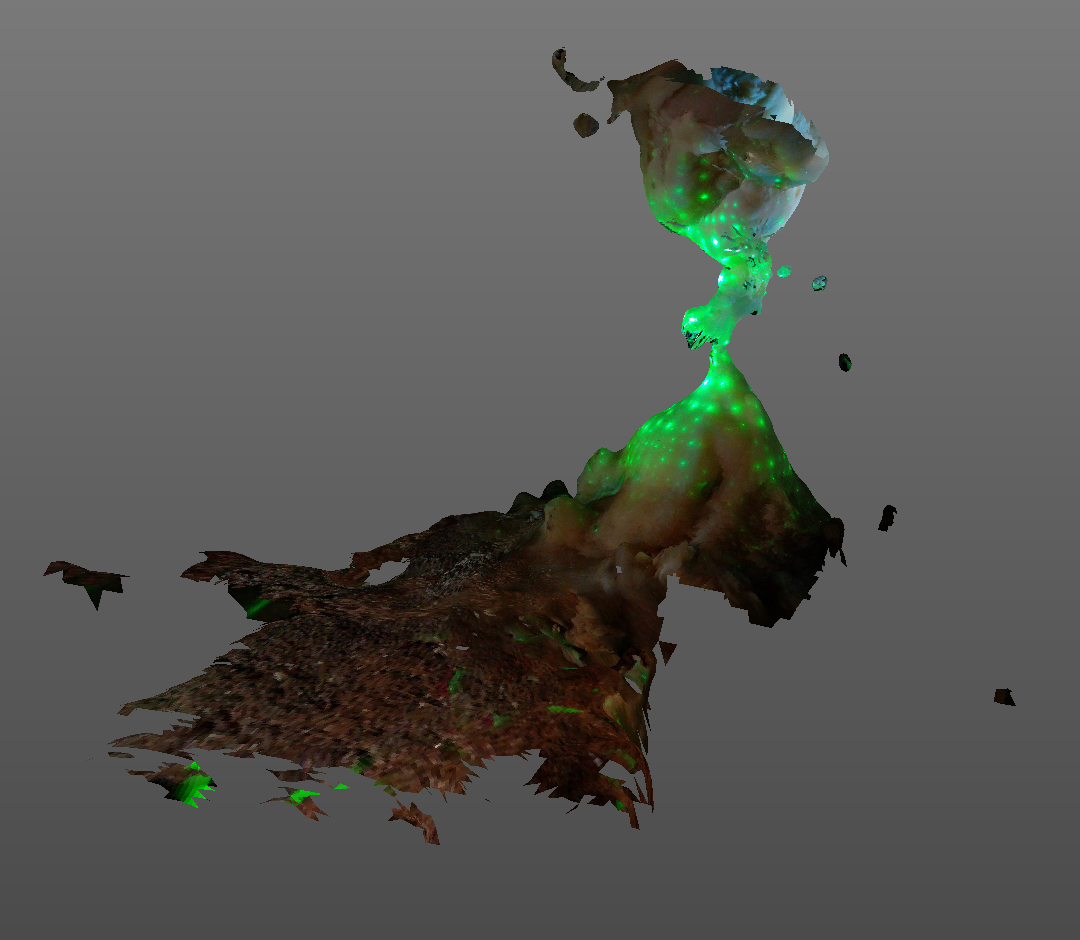
Una volta ottenuto, il modello grafico andava “Pulito” “Riparato” e “Reso stampabile”… E noi che pensavamo che la parte complicata fosse andare lì a fare il rilievo…
Quasi tre mesi di tribolazioni tra programmi per la modellazione 3D e prove di stampa andate male, sembrava che il destino avesse deciso che non dovessimo riuscire nell’impresa. Una prova di stampa effettivamente era riuscita, ma in PLA e con dimensioni di 3 cm di altezza, dato che l’aggetto della parte superiore rendeva estremamente difficoltoso stampare con dimensioni maggiori, quindi restava solo la possibilità di farla in resina bianca. Anche avvalendoci del supporto degli utenti di un forum specifico sembrava non esserci la possibilità di stampare fino a quando Paolo Dori, uno dei fondatori, nonché presidente emerito di SpeleoFotoContest e tecnico addetto alla stampa 3d, annuncia: “Sta stampando! ci vorranno circa 6-8 ore”. Un’attesa che sembrava essere infinita e che purtroppo portò alla comunicazione che non avremmo voluto sentire: “Una parte a metà si è staccata”. Si decide per un ultimo disperato tentativo riducendo di due secondi a ciclo la velocità di stampa, erano le ore 12:00 del 1 Giugno 2022, meno di 24 ore prima dell’apertura del XXIII Congresso nazionale di speleologia di Ormea dove avevamo previsto di presentare in anteprima il premio, e la previsione dava almeno 8-10 ore per stampare 11 cm di sentinella. Alle ore 23:00 il processo era ancora all’80%, avremmo avuto il responso solo la mattina dell’apertura.
Alle 6:29 del 2 Giugno ecco la tanto attesa notizia: “Habemus Sentinella” non ci sembrava vero! mesi di impegno e tribolazioni avevano, infine, avuto una giusta coronazione, ed appena in tempo per la presentazione ufficiale durante la premiazione del Contest.
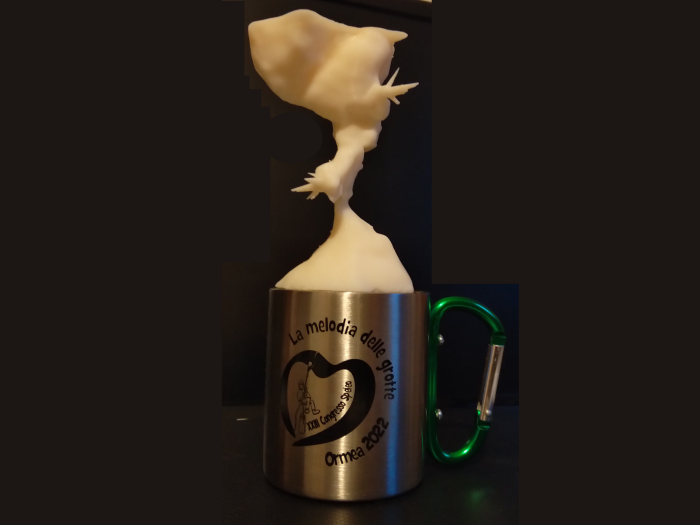
Cosa diventerà il Premio Sentinella? Difficile prevederlo, per adesso è una sfida che siamo orgogliosi di aver portato a termine grazie al lavoro ed all’impegno di tutti, poi vedremo. Una cosa è certa, se il Premio Sentinella avrà un futuro sarà sempre e comunque votato alla trasmissione delle conoscenze speleologiche, siano esse fotografiche o di altra natura, l’Associazione culturale SpeleoFotoContest adesso si arricchisce di un elemento che sarà centrale nelle attività future e che speriamo sia di aiuto nel favorire lo sviluppo della cultura della tutela delle grotte e dell’ambiente carsico.
What is the “Sentry Award“? An idea born in late 2021 and materialized only after a not-so-easy journey with constant doubts about completing it. The “Sentry Award” is the three-dimensional representation of the iconic concretion guarding the treasure room of the Lucchesi Branch in the Antro del Corchia Cave, also a symbol of the SpeleoFotoContest cultural association, which aims to become a symbol of speleological excellence.
The Sentry is a concretion as fascinating as it is fragile, representing the age-old delicacy of the underground world and the importance of its protection to promote knowledge, especially outside the speleological community. After a long gestation period, a project was developed for the creation of a 3D scan, followed by its processing for resin printing to create a model representing it.
Thanks to the crucial collaboration of Daniele Pagli and Paolo Billeri of the Speleological Group GSTSpeolo from Fucecchio FI Italy, preliminary tests were conducted to determine the best solution to overcome the technical difficulties of the project. The chosen technique was photogrammetry, using cameras and smartphones to capture images for processing through software and a specific application.
The use of laser pointers to create a grid of reference points proved to be a practical, economical, and effective solution to enhance the precision of the 3D model’s details. The team made their way to the location, overcame challenges, and successfully captured the model using this technique.
Afterward, the 3D model needed to be cleaned, repaired, and made printable, which turned out to be a complex process. It took almost three months of struggles with 3D modeling software and failed printing attempts.
Eventually, with a last desperate attempt, they managed to print the sentry in white resin just in time for the XXIII National Speleology Congress in Ormea. This marked the successful culmination of months of effort and challenges.
As for the future of the Sentinella Prize, it remains uncertain, but it’s a project that the team is proud to have completed, and it will likely play a central role in the promotion of speleological knowledge and the preservation of caves and karst environments.
